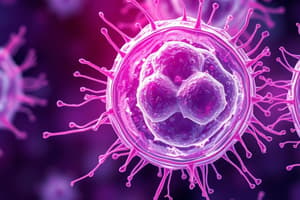Podcast
Questions and Answers
What distinguishes eukaryotic cells from prokaryotic cells?
What distinguishes eukaryotic cells from prokaryotic cells?
- They are smaller in size
- They lack membrane-bound organelles
- They have a nucleus and membrane-bound organelles (correct)
- They lack a nucleus
Which process results in the formation of two genetically identical daughter cells?
Which process results in the formation of two genetically identical daughter cells?
- Meiosis
- Cell signaling
- Cell organization
- Mitosis (correct)
What is the specialized function of myocytes?
What is the specialized function of myocytes?
- Producing genetic material
- Responsible for movement (correct)
- Facilitating cell division
- Production of energy
Which cells are involved in sexual reproduction?
Which cells are involved in sexual reproduction?
How do cells communicate with each other?
How do cells communicate with each other?
Why is the study of cells important according to the text?
Why is the study of cells important according to the text?
Which Dutch microscopist was the first to observe cells through a simple microscope?
Which Dutch microscopist was the first to observe cells through a simple microscope?
According to cell theory, where do cells come from?
According to cell theory, where do cells come from?
What are the two main types of cells based on the text?
What are the two main types of cells based on the text?
Which scientist proposed that all living organisms are composed of cells?
Which scientist proposed that all living organisms are composed of cells?
In which type of cell are membrane-bound organelles absent?
In which type of cell are membrane-bound organelles absent?
What is the fundamental unit of structure and function in living organisms according to cell theory?
What is the fundamental unit of structure and function in living organisms according to cell theory?
Flashcards are hidden until you start studying
Study Notes
Exploring the Building Blocks of Life: Cells in Science
At the heart of all life on Earth are cells — tiny, vibrant, and astonishingly complex units of organization. Discovering the existence of cells and understanding their role in life has been a foundational pillar of modern science. Let's delve into the history and significance of these microscopic marvels.
The Discovery of Cells
In the 17th century, Dutch microscopist Anton van Leeuwenhoek was the first to observe cells through the lens of his hand-built simple microscope. However, it was not until the mid-19th century that the idea of cells as the fundamental unit of life was firmly established by scientists like Theodor Schwann and Matthias Schleiden. These pioneers of cell theory proposed that all living organisms are composed of cells, and cells are the basic unit of structure and function in living organisms.
The Cell Theory
Cell theory has three main principles:
- All living organisms are composed of cells.
- Cells come from pre-existing cells through cell division.
- Cells are the basic unit of structure and function in living organisms.
This concept is still one of the most fundamental principles in biology today.
Types of Cells
Cells vary widely in shape, size, and function. They are often classified into two main types: prokaryotic cells and eukaryotic cells.
Prokaryotic cells, found in bacteria and archaea, have simple cell structures and lack a nucleus or membrane-bound organelles.
Eukaryotic cells, found in organisms like plants, animals, and fungi, have a more complex structure, containing a nucleus and membrane-bound organelles such as mitochondria, the endoplasmic reticulum, and the Golgi apparatus.
Cell Organization
Cells are organized into layers or tissues, and tissues combine to form organs. The human body consists of more than 200 different types of cells, each with a specialized function. For example, the primary cells found in skin are keratinocytes, while muscle cells called myocytes are responsible for movement.
Cell Division
Cell division is the process by which a cell reproduces itself and creates new cells. There are two types of cell division: mitosis and meiosis.
Mitosis is the process of cell division that produces two genetically identical daughter cells. It occurs in somatic cells, which make up the body tissues.
Meiosis is the process of cell division that produces four gamete cells, each containing half the number of chromosomes of the parent cell. This type of cell division is essential for sexual reproduction.
Cell Signaling
Cells communicate and interact with one another through chemical signals called hormones, neurotransmitters, and growth factors. These signals facilitate processes like growth, development, and immune responses.
Conclusion
Cells are the basic units of life, and understanding their structure, function, and interactions is vital to our knowledge of biology. They are incredibly diverse, ranging from the simplest prokaryotic cells to the complex eukaryotic cells found in our own bodies. The study of cells has led to fundamental discoveries in biology, medicine, and technology. As our understanding of cells deepens, we can continue to improve our health, health care, and our view of the natural world.
Studying That Suits You
Use AI to generate personalized quizzes and flashcards to suit your learning preferences.




